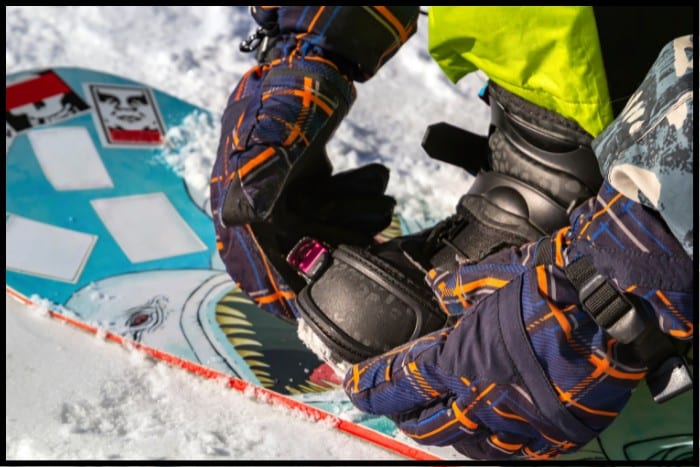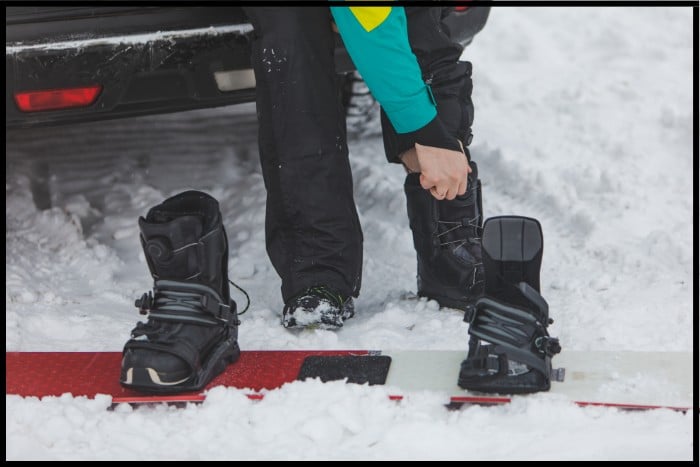Experiencing heel lift in your boots as a snowboarder is a fairly common frustration – your feet aren’t as comfortable, you have to work harder to engage your toe edge, and you put yourself at a higher risk of injury.
Fixing a snowboard boot heel lift is pretty straightforward. The best thing you can do is ensure your boots fit properly in the first place, have a lacing system that offers enough support, and that your liners are molded where possible. You can also use heel inserts or an insole to reduce heel lift.
First, we’ll take a look at what heel hold and heel lift mean and how they affect you when you’re snowboarding. Afterward, we’ll discuss the best ways to fix heel lift and improve your overall snowboarding experience.
What Does Heel Hold And Heel Lift Mean?
Before we look more closely at what heel lift is and how and why to prevent it, it’s important to know what heel hold is and why it’s a critical factor in safe snowboarding.
When we say heel hold, we’re talking about how well your snowboard boot prevents your heel from lifting up from the footbed of the boot while you’re riding.
A boot with poor heel hold results in heel lift, where the heel of your foot slides up the spine of your boot.
Heel lift isn’t really noticeable if you’re straight-lining or using your heel edge to turn or carve, but you’ll feel it when you try to engage your toe edge.
At a fundamental level, snowboarding works by transferring energy and movement from your body, through your feet, boots, and bindings, then through your snowboard and into the snow itself.
Heel lift creates a delay between when your body starts initiating a toe turn and when your foot engages with your boot.
The negative impact on the responsiveness of your snowboard can have a few different knock-on effects.
First, it can reduce the amount of edge control you have when turning, carving down the hill, or landing a trick so you could end up sliding out.
You’re also at a much higher risk of catching an edge and taking a tumble. Plus, you’re going to be working your feet harder in an uncomfortable position which can cause avoidable pain or cramping.

How Can You Fix and Prevent Snowboard Boot Heel Lifts?
As you’ve probably gathered by now, if your heel is lifting to the point that it’s affecting board responsiveness, you should address it quickly.
Fortunately, there are several straightforward solutions to the issue.
1. Correct Boot Size
When it comes to fixing heel lift, the first step you can take is also the most obvious: you’ll want to make sure your snowboard boot fits properly.
If you’ve had your boots for a long time and you’re starting to experience heel lift when you hadn’t before, there’s a good chance you can chalk it up to general wear and tear, and it might be time to invest in a new pair.
There are fixes to extend the life of your older boots, which we’ll come to shortly, but if your boots are relatively new and your heels are lifting, they may be too big for you.
Generally, your toes should just about reach the end of your boots when standing upright and come away slightly when you flex your knee forward over your foot.
However, not all feet are shaped the same, so while you may have the right-sized boot for the length of your feet, if your feet are on the narrower side, the boot may not be tight enough to hold your heel effectively.
When it comes to buying new boots, we always recommend trying on a few different pairs at your local snowboard shop to get an idea of how different brands fit and consult a gear expert.
2. Lacing
Even if your snowboard boots are the perfect size for your feet, you might still experience heel lift if your feet aren’t secured properly.
Unlike regular boots, snowboard boots come with a range of lacing styles which can be used in numerous combinations to varying effects.
The best lacing systems for avoiding heel lift are those that allow you to tighten different sections of the boot independently.
These styles of boot let you secure the lower half of your boot more tightly than the upper section so you can increase heel hold without increasing unwanted pressure on your shins.
In most mid-to-high-range boots, you’ll also find a lockable inner lacing harness for the boot liner that lets you secure your heel independently of the outer shell.
3. Mold Your Liners
Like regular boots, snowboard boots almost always require some breaking in to conform to the shape of your feet and minimize issues like heel lift.
In fact, most modern boots come with specially moldable EVA polymer liners to ensure you get the highest level of comfort and responsiveness out of them.
However, even moldable liners come in different forms; self-molding or heat moldable.
Technically, both liner types use heat to mold to your feet: self-molding liners use your body’s natural warmth to soften the lining, whereas heat-molded liners require an external source.
Molding the former is straightforward enough, as the longer you wear them, the more they’ll conform to your feet to provide that extra support. The latter, however, requires a little more effort.
If your liners are heat-moldable, simply take your boots to your local snowboard shop (or ask at the time of purchase).
They should take care of everything for you, heating the liners up and getting you to stand in your boots for around ten minutes while they cool.
If this isn’t an option, you can easily mold your liners at home with a hairdryer; however, be extra careful not to overheat the material as it can degrade and ruin the fit completely.
The advantage of heat moldable liners is that if you’re unsure the fit is correct, you can always reheat them and try again.

4. Heel Inserts
If you’ve made sure that your boots are the right size, you’re satisfied with your lacing, and you’ve done your best to mold your liners, but you’re still dealing with heel lift, then it’s worth considering getting specialized boot inserts.
J-Bars or C-Pads
J-bars and C-pads are simple and inexpensive solutions to heel lift that anyone can fit in moments.
They’re effectively just J- or C-shaped self-adhesive foam/rubber inserts that you stick to the outside of your boot liner on each side so they fit around your ankle bone.
J-bars and C-pads help eliminate excess space in your boot and increase heel hold.
Butterfly Wraps
If you’ve tried J-bars or C-pads and it still feels like there’s too much space in your boot causing heel lift, then it’s time to try butterfly wraps instead.
They work the same way, except where J-bars and C-pads come in pairs, butterfly wraps wrap around the back of the ankle, providing even more padding.
Insoles
Your issues with heel lift might stem from your arch shape, in which case you’ll want to look into purchasing some insoles for your snowboard boots.
My guide on the best snowboarding boot insoles will help you find a great one!
If you wear insoles in any of your other footwear, it’s a good indicator you’ll need them for snowboarding, too, especially as they’ll reduce general pain and discomfort when you’re riding.
While you can use regular shoe insoles in your snowboard boots, it’s definitely worth looking into snowboarding-specific insoles.
These generally provide the extra support and specialized cushioning needed for snowboarding and extra insulation.
If you’re feeling extra fancy and hate the cold, you can even splurge on battery-powered heated insoles.
Conclusion
At the end of the day, while heel lift is definitely an issue for snowboarders, it’s also a really easy fix.
The best way to avoid heel lift in the first place is to do your research thoroughly before buying a pair of boots to make sure they fit as well as possible, and if you can, invest in boots that have a superior lacing system and custom-fit liners.
If you’re still experiencing heel lift or can’t quite afford a new pair of boots yet, and, let’s be honest, even low-end snowboard boots don’t come cheap, then you should be able to solve the problem with inexpensive heel inserts or an insole.
